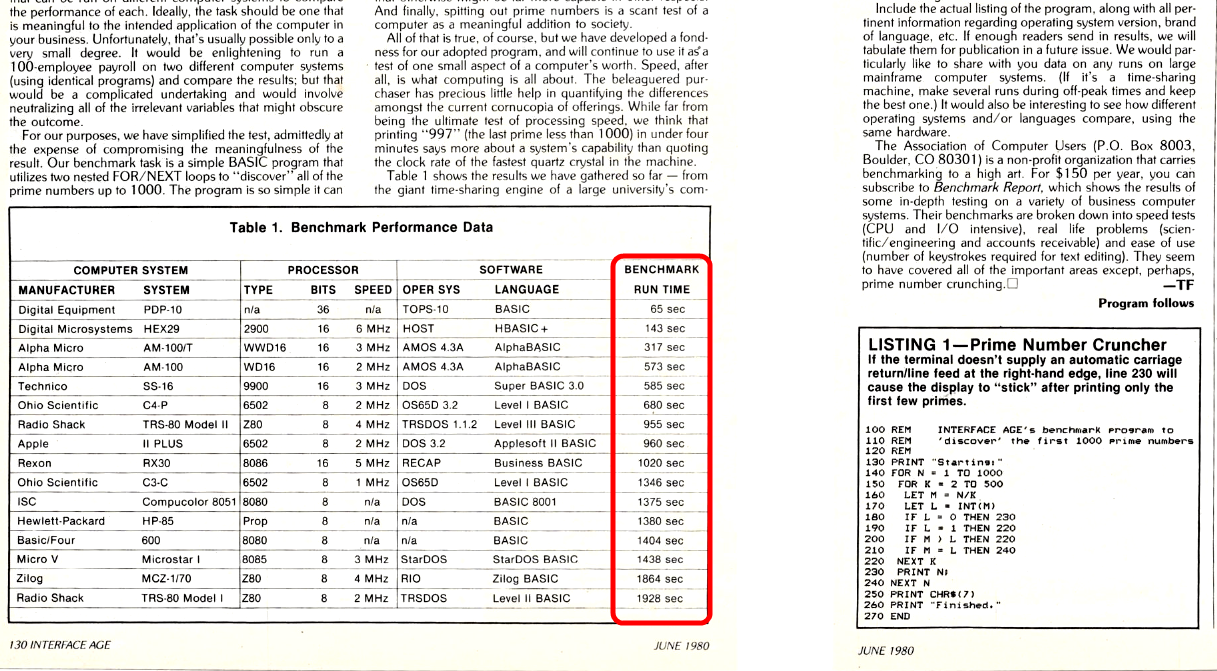The history of Tiny Basic programming language goes back to the same era when first home/hobby microcomputers powered by 8-bit microprocessors started to appear.
Due to ROM/RAM size limitations (2kB each) and the CPU used (8080), the choice of Tiny Basic fell on this version:
;*************************************************************
;
; TINY BASIC FOR INTEL 8080
; VERSION 2.0
; BY LI-CHEN WANG
; MODIFIED AND TRANSLATED
; TO INTEL MNEMONICS
; BY ROGER RAUSKOLB
; 10 OCTOBER,1976
; @COPYLEFT
; ALL WRONGS RESERVED
;
;*************************************************************
I took the Tiny Basic source code from CPUville site (by Donn Steward which has many other great retro-computing resources there too) and made two modifications:
(1) changed from Intel 8251 UART to Motorola 6850 ACIA (I/O port locations and control / status register bits):
;--- definitions for Intel 8251 UART ------
;UART_DATA EQU 2H
;UART_CTRL EQU 3H
;UART_STATUS EQU 3H
;UART_TX_EMPTY EQU 1H
;UART_RX_FULL EQU 2H
;UART_INIT1 EQU 4EH ;1 STOP, NO PARITY, 8 DATA BITS, 16x CLOCK
;UART_INIT2 EQU 37H ;EH IR RTS ER SBRK RxE DTR TxE (RTS, ERROR RESET, ENABLE RX, DTR, ENABLE TX)
;--- definitions for Motorola 6850 ACIA ---
UART_DATA EQU 11H
UART_CTRL EQU 10H
UART_STATUS EQU 10H
UART_TX_EMPTY EQU 2H
UART_RX_FULL EQU 1H
UART_INIT1 EQU 03H ; reset
UART_INIT2 EQU 10H ; 8N1, divide clock by 1
;
(2) fixed the "overflow on change sign" bug
When changing the sign of 16-bit 2's complement integer, there are two cases when the MSB stays the same - from 8000H (-32768) to 8000H (and this is an overflow error) and from 0000H to 0000H (not an error). This second case was not handled in original (and was causing HOW? error message when I first ran the benchmark program).
;
CHGSGN: MOV A,H ;*** CHGSGN ***
PUSH PSW
CMA ;CHANGE SIGN OF HL
MOV H,A
MOV A,L
CMA
MOV L,A
INX H
POP PSW
XRA H
JP QHOW
MOV A,B ;AND ALSO FLIP B
XRI 80H
MOV B,A
RET
;
CHGSGN: MOV A,H ;*** CHGSGN ***
PUSH PSW
CMA ;CHANGE SIGN OF HL
MOV H,A
MOV A,L
CMA
MOV L,A
INX H
POP PSW
XRA H
JM FLIPB ;OK, OLD AND NEW SIGNS ARE DIFFERENT
MOV A,H
ORA L
JNZ QHOW ;ERROR IF -(-32768)
FLIPB: MOV A,B ;AND ALSO FLIP B
XRI 80H
MOV B,A
RET
To assemble into binary I used zmac cross-assembler, with -8 command line flag to use the 8080-style mnemonics (instead of default Z80-style). Note that the VHDL project in ISE 14.7 which produces the .bin file to download to FPGA is using the .hex file output, not the .bin (which would be the case in programming EPROMs for example). This process is described in a separate project log.
Running and benchmarking
To test the Tiny Basic, I used the benchmark test program proposed by June 1980 Interface mag article - a very simple algorithm to find first 1000 prime number. Only two minor modifications were done - as Tiny Basic has no INT() - because doesn't support floating point numbers, and commenting out CHR$(7) (which on many somewhat compatible ANSI platforms would produce a beep "bell")
100 REM -------------------------------------
101 REM Simple benchmark - find primes < 1000
103 REM -------------------------------------
104 REM https://archive.org/details/InterfaceAge198006/page/n131/mode/2up
110 REM -------------------------------------
130 PRINT "Starting."
140 FOR N = 1 TO 1000
150 FOR K = 2 TO 500
160 LET L = N/K
170 LET M = N-K*L
180 IF L = 0 GOTO 230
190 IF L = 1 GOTO 220
200 IF M > L GOTO 220
210 IF M = L GOTO 240
220 NEXT K
230 PRINT N;
240 NEXT N
250 REM PRINT CHR$(7)
260 PRINT "Finished."
270 STOP
Results running at different CPU clock frequencies:
104 REM https://archive.org/details/InterfaceAge198006/page/n131/mode/2up
105 REM SW210 CPU (MHz) Result (s)
106 REM 100 01.5625 52m23 3143
107 REM 101 03.1250 26m12 1572
108 REM 110 06.2500 13m06 786
109 REM 111 25.0000 3m17 197
110 REM -------------------------------------
It can be seen that the execution speed is in strong linear correlation with CPU clock frequency (this is expected because serial I/O is sparsely used, and memory interface never adds any wait cycles, always follows CPU speed - not a case in many real computers of that era). 8080 running at 25MHz "warp speed" is comparable to another exotic bit-sliced processor of the era (HEX-29 was AMD's "showcase design" introduced in the classic bit-slice design cookbook) at 6MHz, while at the more realistic 3.125MHz it is comparable to the 3MHz 8085-based computer of the era (Intel 8080A was rated to max 2MHz clock frequency).
(image from LALU (lookup ALU CPU))

 zpekic
zpekic
Discussions
Become a Hackaday.io Member
Create an account to leave a comment. Already have an account? Log In.